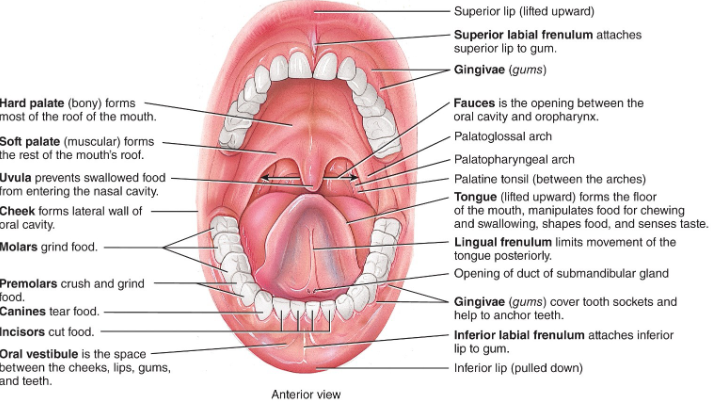-
What are the 2 major sections of the digestive system?
1. The Gastrointestinal (GI) Tract
2. The Accessory Structures
-
The GI tract is tube that connects and opens at both ends of the body. Name the organs and parts that are part of the GI tract.
- esophagus
- stomach
- small intestine
- large intestine
- rectum
-
The accessory structures contribute to food processing. Name the parts associated with the accessory structures.
- teeth
- tongue
- salivary glands
- liver
- gall bladder
- pancreas
-
What is the purpose of the digestive system?
To break down food into smaller pieces to enter body cells for their use, otherwise they are too big to be properly absorbed.
-
Name and describe the 6 functions of the digestive system.
1. Ingestion: intake of food into the mouth.
2. Secretion: the release of water, enzymes, acids and other into the lumen of the digestive canal.
3. Mixing and propulsion: the churning and contraction of food through the GI tract (peristalsis)
4. Digestion: the mechanical and chemical breakdown of food into their more basic parts
5. Absorption: the passage of digested products into blood plasma and lymph plasma
6. Defecation: elimination of feces through the anus
-

Label this diagram

-
Name the layers of the GI tract from most superficial to deepest.
1. Serosa (areolar CT and epithelium)
2. Muscularis (circular and longitudinal muscle)
3. Submucosa
4. Mucosa
-
What type of epithelium is in the mouth, pharynx and esophagus?
Non-keratinized stratified squamous cells
-
What type of epithelium is in the stomach and intestines?
Simple columnar cells for secretion and absorption.
-
What does the muscularis mucosa do?
It causes the folding of the surrounding tissue to increase SA for greater digestion and absorption (allows more product to be digested as a result of ^SA).
-
What does the enteric nervous system entail?
- The submucosal plexus
- The myenteric plexus
-
What does the submucosal and myenteric plexus do?
Submucosal: controls the salivary glands which helps regulate chemical digestion.
Myenteric: regulates mechanical digestion due to its control over the circular and longitudinal muscles (peristalsis).
-
What is the name of the membrane that protects the abdominal cavity?
The peritoneum and it is the largest serous membrane in the body.
-

Label the diagram and name the parts that they protect.

Falciform ligament - in the liver
Lesser omentum - stomach
Greater omentum - entire intestine
-
The falciform ligament, and the lesser and greater ligament, the mesocolon and mesentery are folds in the peritoneum that support organs and contain blood vessels of the abdominal cavity. True or false?
True
-
What part of the peritoneum contributes the most to having a "beer belly" and why?
The greater omentum because it contains a lot of adipose tissue.
-
What are the retroperitoneal (behind the peritoneum) organs?
- kidneys
- suprarenal glands
- pancreas
-
What does the uvula do?
Prevents swallowed food from entering the nasal cavity.
-
What is the oral vestibule?
The space between the cheeks, lips, gums and teeth.
-
What does the lingual frenulum do and why might it be important?
It limits the movement of the tongue posteriorly and if it limits the tongue too much, could hinder a person's speech.
-
What is the mouth formed by?
It's formed by the cheeks, hard and soft palates and the tongue.
-

Label the diagram.

-
What are the 3 pairs of salivary glands and what do they do?
1. Parotid
2. Submandibular
3. Sublingual
Outside of the mouth and empty saliva into ducts that do into the oral cavity.
-
What does the enamel do?
Outer layer of the tooth and protects it from wear and tear. Translucent in colour.
-
What does the periodontal ligament do?
It helps anchor the tooth to the underlying bone.
-
What does the apical foramen do?
Opening/hole at the base of the root canal where blood vessels and nerves enter a tooth.
-
Define mechanical and chemical digestion?
Mechanical - the act of chewing product with saliva and turning it into bolus in the mouth.
Chemical - salivary amylase breaking down chemicals into their smaller and baser forms (ex. polysaccharides > monosaccharides)
-
Why does the trachea contain cartilaginous rings but not the esophagus?
The trachea requires the rings to maintain their shape and to keep the airway open. But with the esophagus it doesn't need to maintain its shape when its empty, which makes it collapsible.
-
What is the outer layer of the esophagus called?
the adventitia
-

Label the diagram.

-
What type of muscle is the esophagus made of?
Partly skeletal, and partly smooth.
-
What is Gastroesophageal Reflux Disease (GERD)?
When the contents of the stomach go back to the esophagus because of the lower esophageal sphincter failing to close after food has entered the stomach.
-

Label the diagram.

-
Pepsin digests ___ and the intrinsic factor digests ___.
Pepsin - protein
Intrinsic - vitamin B12
-
What are the subdivisions of the stomach?
- cardia
- fundus
- body
- pylorus
-
What are the functions of the stomach?
1. Forms chyme by mixing saliva, food and gastric juices.
2. Is a reservoir for food before it goes to the small intestine.
3. Secretes gastric juice which has HCl, pepsin, intrinsic factor and gastric lipase.
4. Secretes gastrin into the blood.
-
Why do we need mucus in the stomach?
To lubricate food and to protect your own cells in the stomach.
-
What are the three types of cells formed by gastric glands?
- mucuous neck cells (secrete mucus)
- parietal cells (secrete HCl and intrinsic factor)
- chief cells (secrete pepsinogen and gastric lipase)

